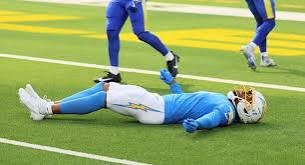
Introduction
The Los Angeles Chargers’ dynamic wide receiver, Quentin Johnston, recently endured a worrying head injury during a preseason matchup against the Rams. This article delves deep into his current health status, examines his college performance with a focus on drop rates, and explores how these factors shape his NFL trajectory. Let’s break down the key developments.
1. The Injury: What Happened?
On August 16, 2025, during a preseason game at SoFi Stadium, Quentin Johnston took a brutal hit to the head from Rams safety Tanner Ingle on the third play from scrimmage. He fell motionless, prompting an immediate medical response. After several tense moments, Johnston began moving, sat up, and walked to a cart—but notably slammed one of his gloves down in frustration before departing the field.
Coach Jim Harbaugh later confirmed that Johnston had sustained a concussion. Despite the severity of the hit, Harbaugh noted some positives: Johnston was conscious, could recall the play, was moving well, and spoke coherently. He was immediately taken to a hospital for thorough evaluation, including X-rays.
As per RotoWire and various outlets, Johnston will now be subjected to the full NFL concussion protocol, required before he can return to practice or game action.
Summary of the injury:
-
Date: August 16, 2025
-
Nature: Concussion, confirmed by medical evaluation
-
Initial Reaction: Walked off the field, but visibly frustrated
-
Next Steps: Hospital evaluation and concussion protocol adherence
2. College Career and Drop Rate Concerns
Before turning pro, Johnston played at TCU, where he exhibited elite physical traits—standing 6’4” with reported 40-inch-plus vertical and blazing speed. Yet, analysts flagged a concerning drop rate of 11.8% in his final college season.
This figure is significant because receivers entering the NFL with drop rates above ~11% have historically struggled in the pros. Data since the 2018 draft shows that few first-round pick receivers with similarly high drop rates have found consistent success. Though Johnston had exceptional physical tools, this cited inconsistency raised red flags.
Key comparisons:
| Player | Final NCAA Drop Rate | NFL Outcome |
|---|---|---|
| Jalen Reagor | ~14% | Limited impact |
| Rashod Bateman | ~14.3% | Underwhelming output |
| Darnell Mooney, Diontae Johnson | 12–14%+ | Moderate success but lower draft position |
Johnston’s 11.8% drop rate sits near this threshold, spotlighting the importance of consistency in ball catching—a fundamental for long-term success.
3. College Stats at a Glance
Johnston’s college stats spotlight both his potential and areas of concern:
-
ADOT (Average Depth of Target): Over 17 yards during his first two seasons; dipped slightly in his final year.
-
Physical Profile: Exceptional size, speed (40-yard dash in the 4.3-4.4 range), and vertical leap.
-
Drop Rate: 11.8% in the final NCAA season—significantly high.
These stats paint a picture of a deep-threat receiver with tantalizing athleticism—but with an important issue that NFL coaches must address early in his career.
4. Jonathan’s NFL Journey so Far
2024 Season Performance
In his second NFL season (2024), Johnston showed marked improvement:
-
55 catches on 91 targets
-
711 receiving yards
-
Team-leading 8 touchdowns in 15 regular-season games (11 starts) ReutersNFL.comESPN.com
-
Career totals (through 32 games): 93 catches, 1,142 yards, and 10 TDs
Preseason 2025
Johnston entered the 2025 preseason expected to be a key deep-ball weapon for the Chargers. However, this concussion could impact his preparation and readiness for the regular season.
5. Drops in the NFL: Is It a Recurring Issue?
There’s ongoing concern from fans and analysts about Johnston’s reliability in catch situations. For instance, on Reddit’s r/DynastyFF, one comment noted:
“Putting aside that it’s tacky to make fun… you can see the defensive back tip the ball before it gets to him.”
Another quipped:
“Sadly no one will acknowledge that… just QJ dropping another ball.”
These sentiments underscore that perceived drops continue to influence the narrative around him.
6. What This Means for His Future
Short-Term Outlook
Johnston must now complete the NFL concussion protocol, which typically includes symptom clearance, cognitive testing, and a staged return to physical activity. The Chargers will likely proceed cautiously, but team insiders remain optimistic about his recovery.
Long-Term Prognosis
To fulfill his potential, Johnston must:
-
Maintain consistent health and avoid recurring injuries
-
Address drop issues through coaching, technique refinement, and repetition
-
Capitalize on his deep-threat abilities while improving reliability
If he achieves this balance, Johnston could evolve into a premier outside target in the Chargers’ offense.
Conclusion
Quentin Johnston’s recent concussion is a serious setback, but the early indicators—his immediate responsiveness and hospital evaluation—offer cautious optimism. His collegiate drop issues remain a concern, yet his athletic traits and second-year progression hint at elite upside. The upcoming weeks will be pivotal: recovery progress, adherence to the concussion protocol, and how he responds in training and preseason will determine whether Johnston can turn undeniable potential into sustained NFL production.
